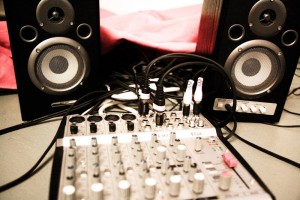
In general, as a second-year BA student, one is more or less adapted to both the academic and the current affairs at ECLA. I thought I knew what to expect, even when choosing a ‘studio art class’ (Installation, led by David Levine). But, believe me, I wouldn’t have expected to be writing this article in an empty room surrounded by: wires, bulbs, microphones, speakers, mp3 players, adapters (4 or 5 types) and other whatnots (from pieces of fabric to little bells).
Since the idea for the first installation project has come to me, I have been frantically searching in shops all over Berlin, on the Internet and in and around the campus, for objects and materials that could potentially be part of it. And imagine that with every crazy material or object I find, the idea, in turn, also changes. I am literally haunted.
Now that I told you about the atmosphere in which I am writing, let me go into some facts. During the first class, someone asked David Levine, our guide into the technical and even possibly the metaphysical intricacies of contemporary art: “So, are we going to get a studio?” I intervene: “Yes, your room.” David pauses with a questioning glance, “No, you’re actually getting an individual studio, each. And you have a budget for the four projects you have to prepare.” And here it all begins!
The course is structured around three main technical aspects of installation: sound, light and video. For each of the modules you have to produce a studio installation that is exhibited to the public after having learned the basics (or rather, I should say: after having struggled with the devices, and out of desperation, kept trying; switching cables and adapters until you managed to play something through the mixing board). For each of the project, you criticize and receive criticism. Meanwhile throughout the course, you get to know more about contemporary art, especially the ‘genealogies’ of installation.
To be honest, the reason why I decided to join the class is because of the special interest I have in performance. And I thought I knew how it felt to be ‘haunted’ by an idea that seeks expression because I write poetry. But, again, this is something entirely different.
The range of possibilities of expression that one has when creating an installation piece is enormous. The space, the direct interaction with your spectator, the three-dimensionality of reality as it is at your will, in any movement, in any combination—all this is overwhelmingly open and beyond any medium (words, colors, solid materials, etc).
So, this is how things look just a few days before the first public show, when our colleagues and professors (and maybe some other people, too), will be stepping into these rooms as spectators.
I finally manage to separate two channels of sound on my mixing board. I add some headphones. I change frequencies. I plug and unplug. I see how it all will happen. And then I go blank again. I connect a microphone and talk randomly. Soundcheck: “One, two. Testing. Testing. One, two. Three.”
by Aurelia Cojocaru (2nd year BA, Moldova)
